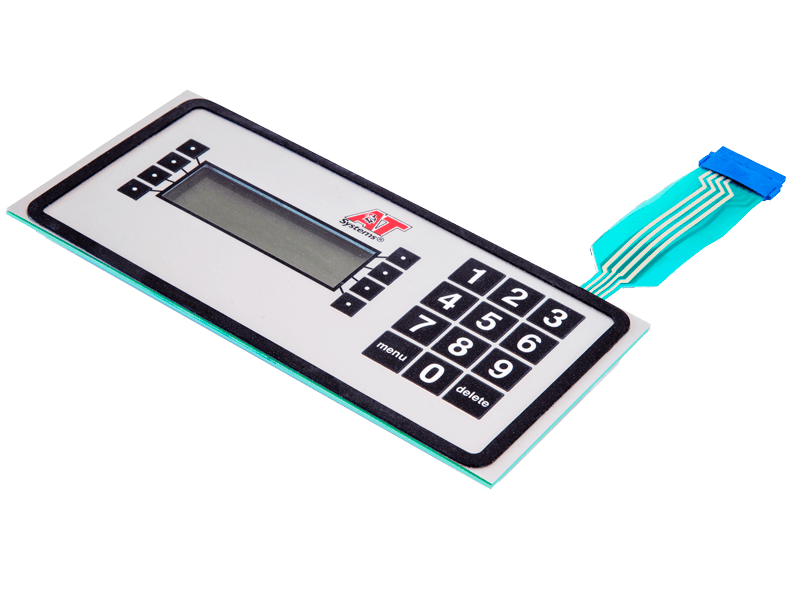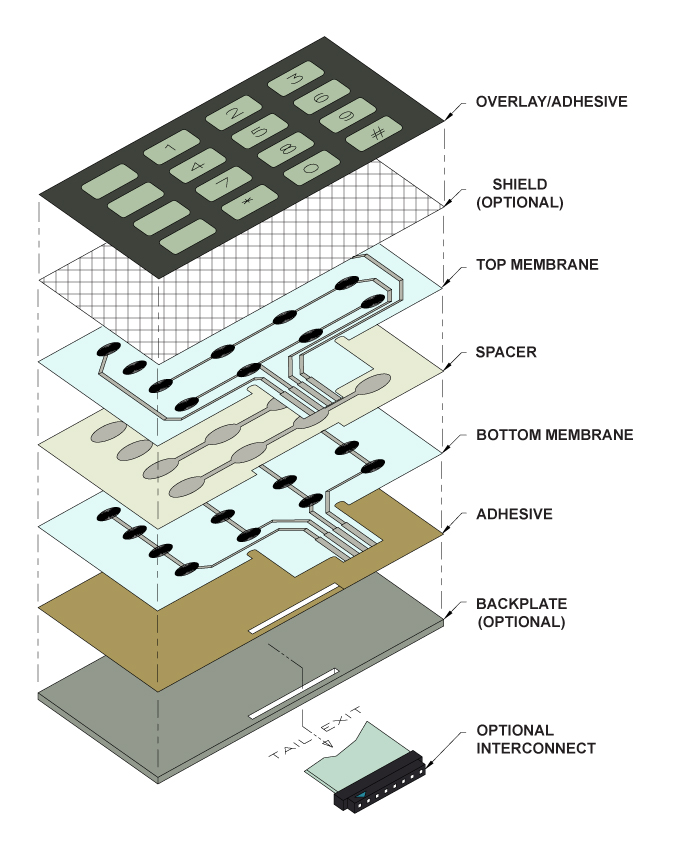A reliable membrane switch manufacturer offers both trial and mass production options.
A reliable membrane switch manufacturer offers both trial and mass production options.
Blog Article
All About Membrane Switch Over: Comprehending Its Design and Functionality
When you think regarding the control user interfaces in modern-day devices, membrane layer switches often come to mind. These elements are greater than just switches; they blend layout and functionality flawlessly. Comprehending exactly how they function and what makes them efficient can change your point of view on day-to-day electronics. However, there are subtleties to their design and performance that you may not understand. Allow's explore what sets membrane switches aside from various other control systems.
What Are Membrane Layer Switches?

Their smooth nature makes them easy to clean and resistant to dust and wetness, an essential feature in lots of settings. Membrane layer buttons can additionally be personalized regarding form, dimension, and graphics, enabling producers to create distinct interfaces tailored to particular products. Plus, they're lightweight and slim, which assists in minimizing the overall bulk of gadgets. In general, membrane buttons play a significant role in improving user experience across a wide range of applications.
Just How Membrane Layer Switches Over Work
When you push a trick on a membrane switch, it turns on a straightforward yet efficient system. membrane switch manufacturer. The top layer, commonly made of flexible product, presses down onto a conductive layer underneath it.
You'll discover that the responsive responses differs based on the button design, offering either a soft click or an extra noticable response. Once you release the trick, the membrane returns to its original placement, resuming the circuit and quiting the signal. This procedure occurs nearly immediately, making sure a responsive user experience.
Membrane buttons are preferred because of their longevity and resistance to dust and dampness, making them suitable for numerous applications, from house home appliances to clinical gadgets. Recognizing this operation assists you value their prevalent use.
Key Elements of Membrane Switches
Recognizing the essential components of membrane layer buttons is essential for comprehending their functionality and layout. At the core, you'll discover the visuals overlay, which offers the visual interface for customers. Under that, there's a spacer layer that divides the circuit layers, guaranteeing that they don't make contact until pushed. The circuit layer is where the magic happens; it includes conductive traces that finish the circuit when you push the switch. An additional essential element is the glue support, allowing the button to abide by surfaces securely. The protective layer guards versus ecological variables and wear, extending the switch's lifespan. Each element plays a significant duty in ensuring dependable performance and user interaction. By comprehending these components, you'll obtain insight right into exactly how membrane layer switches over run and their value in various applications.
Products Used in Membrane Layer Switch Layout
The performance and toughness of membrane layer switches heavily rely on the materials used in their layout. You normally experience polyester and polycarbonate as primary substrates due to their superb stamina and adaptability. These products withstand scrapes and chemicals, making them optimal for demanding settings.
The conductive layers commonly utilize silver or carbon, selected for their reliability and conductivity. membrane switch manufacturer. Silver supplies superior performance, while carbon is an economical alternative. For the overlay, you may think about a matte or shiny finish, depending upon your visual demands and user experience
Make why not try here certain to choose adhesives that withstand ecological factors like temperature level and moisture. Choosing the ideal products will ensure your membrane switch stands the examination of time.
Layout Factors To Consider for Membrane Buttons
While making membrane layer buttons, it's important to consider various aspects that affect their performance and customer experience. Beginning by concentrating on the format and button dimension; make particular they're intuitive and very easy to navigate. Think about the tactile responses you desire to give-- will customers need a noticeable click or a softer touch? Additionally, believe regarding the materials you'll use, as they'll influence resilience and visual appeals.
Do not forget the visuals design; clear labeling and color contrast are significant for exposure. Verify your layout suits environmental elements, like wetness or temperature variants, which can affect efficiency. Keep in mind the relevance of testing prototypes with real customers to gather feedback and make required changes. This iterative procedure aids you refine the design, validating it meets both useful and visual needs efficiently. By very carefully considering these components, you'll develop a membrane button that boosts use and fulfillment.
Applications of Membrane Switches
Membrane buttons are versatile elements discovered in numerous applications, from commercial devices to consumer electronics. You'll see their influence in devices that need long lasting user interfaces and in tools that take advantage of smooth layouts. Understanding these applications aids you appreciate the capability and usefulness of membrane layer buttons in daily technology.
Industrial Tools Use
When you're looking to improve the performance of industrial tools, membrane buttons offer a trusted option that combines longevity with user-friendly layout. These switches are best for the original source severe atmospheres, offering resistance to dirt, dampness, and chemicals. You'll discover them in control panels for manufacturing devices, HVAC systems, and clinical devices, where accuracy and responsiveness are essential. Their low profile suggests they fit effortlessly right into different equipment, conserving beneficial space while preserving convenience of use. With personalized graphics and backlighting options, you can produce an instinctive interface for drivers, improving performance and safety. And also, their lengthy lifespan reduces upkeep expenses, making them a smart investment for your industrial applications. Embrace membrane layer buttons to streamline your procedures and boost overall efficiency.
Consumer Electronics Combination
In the domain of consumer electronic devices, membrane layer buttons play a crucial duty in boosting individual communication and tool functionality. Membrane layer switches also assure durability and resistance to dust and wetness, prolonging the life-span of your electronic devices. By picking membrane layer buttons, you enhance not just the performance but also the style of your devices, making day-to-day communications smooth and delightful.
Benefits and Drawbacks of Membrane Switches
While membrane buttons supply an array of advantages, they also feature some drawbacks that you must think about. One considerable benefit is their small style, making them ideal for space-constrained applications. They're also cost-effective, supplying a sturdy remedy with a low manufacturing expense. Furthermore, their seamless surface area is easy to tidy, enhancing hygiene in atmospheres like medical facilities.

Nonetheless, there are negative aspects. Membrane switches can have a much shorter life-span compared to mechanical buttons, especially under heavy use. They can likewise be less tactile, which could impact user feedback during procedure. If damaged, fixing them can be tough and commonly calls for full substitute. Eventually, their sensitivity to severe temperatures and ecological conditions may limit their efficiency in certain setups. Stabilizing these advantages and disadvantages will help you identify if membrane layer switches are the right fit for your job.
Frequently Asked Inquiries
How Much Time Do Membrane Switches Over Normally Last?
Membrane changes usually last in between 5 to ten years, depending upon usage and environmental problems. You'll wish to review factors like wear, direct exposure to moisture, and more tips here temperature fluctuations to evaluate their durability properly.
Can Membrane Switches Be Personalized for Details Designs?
Yes, you can tailor membrane layer switches to fit certain styles (membrane switch manufacturer). You'll have the flexibility to pick shades, forms, and designs that match your project's demands, guaranteeing they blend seamlessly with your overall aesthetic
What Is the Price Range for Membrane Layer Change Production?
The price array for membrane layer switch manufacturing normally drops in between $1 and $10 each, relying on variables like layout complexity, quantity, and products. You can obtain quotes from makers to discover the most effective alternative.

Are Membrane Layer Switches Water Resistant or Resistant?
Membrane buttons can be made to be water-proof or resistant, depending on materials utilized and construction approaches. If you require them for wet environments, ensure you define those requirements throughout the design procedure.
How Do Membrane Switches Over Contrast to Standard Switches?
Membrane switches are generally thinner and a lot more versatile than standard buttons, providing a smooth layout. They're often much easier to clean and integrate, but may not supply the tactile comments you're made use of to with mechanical choices.
Conclusion

Report this page